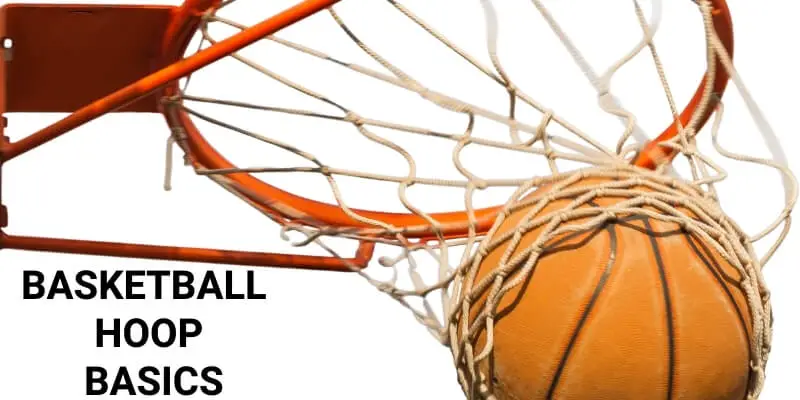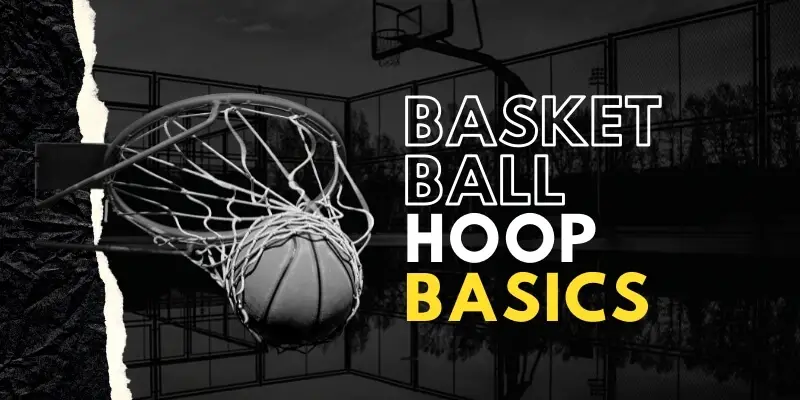The definition of a basketball hoop is an orange circular metal ring or rim with a net attached to a backboard. It is the most important piece of basketball equipment as it is used to score points.
Height of a Basketball Hoop
The standard (normal) height basketball hoops are always 10 feet (3.05 meters) above the ground, no matter where you are playing. From junior high school to professional level, they have the same standard height of 10 feet tall. But some leagues for young basketball champs have shorter hoops than 10 feet.
Diameter of a Basketball (NBA) Hoop
The rim of the basketball hoop has an inner diameter of 18 inches(0.4572) meters.

Components of a Basketball Goal or Hoop System
Generally, a basketball goal or hoop system has the following components.
- Backboard
- Rim or ring
- Net
- Metal post or pole
- Base (Only for portable basketball hoops)
1. Backboard
The backboard is the part of a basketball hoop that holds the rim. They are available in different types, shapes, sizes, and materials.
Shape: Backboards are available in two different shapes: Rectangular (regulation backboards) and fan-shaped (non-regulation backboards)
Size: A regulation basketball backboard is 6 feet (72 inches) wide and 3.5 feet (42 inches) tall. Its inner rectangle is 2 feet (24 inches) wide and 1.5 feet (18 inches) tall.
Non-regulation basketball backboards are available in different sizes. Smaller backboards are 44 to 54 inches wide, whereas mid-size backboards are 60 inches wide.
Material: Basketball backboards are made with different materials, including tempered glass, acrylic, polycarbonate, and composite or plastic.
- The most expensive material is tempered glass. Professional-level backboards are made from tempered glass. It is the most rebound-friendly material.
- Acrylic-made backboards look almost similar to tempered glass backboards. They offer decent rebounds and are lighter, more durable, and cost-effective.
- Polycarbonate is the most durable material for backboards but has a weaker rebounding effect.
- Composite or plastic is the cheapest backboard material, only suitable for kids.
2. Rim of the hoop
Basketball rims are typically made with high-tensile carbon steel. They are available in two different types: standard and breakaway.
Standard rim: It is the most common and the most affordable option, but it can’t be used for dunking because it doesn’t have springs.
Breakaway rim: It is used in professional-level games. It features springs that allow the players to dunk the ball. These rims can withstand the weight of the players to keep the backboard free from damages. They are divided into exposed and enclosed rims, where the enclosed one is the best of all.
3. Net
Basketball nets are attached to the rims and are made up of polyester, nylon, and steel chain.
4. Metal post or pole
These vertical metal posts or poles are the support structures to which the backboards are attached. You will find these poles in both the in-ground and portable basketball hoops. They are divided into three types: one-piece, two-piece, and three-piece.
One-piece support pole: It is the most stable type and is usually used in in-ground basketball hoops.
Two-piece support pole: It has a medium level of stability, but it is the safest option available.
These support poles are also adjustable. You can adjust the height of the rim according to your choice.
Three-piece support pole: It is the least durable option.
5. Base
The base is the part of a portable basketball hoop filled with water or sand to provide stability to the pole and the hoop.
Types of Basketball Hoops
There are different types of basketball hoops.
- In-ground hoops
- Wall mounted hoops
- Portable hoops
In-ground basketball hoops
In-ground basketball hoops are fixed into the ground with the help of cement or concrete. These are permanent structures that last longer and come with a height adjustment feature. The main elements of in-ground hoops include a backboard, a rim with a net, and a support pole.
These in-ground hoops are the most stable structures due to concrete installation. Also, they require less space for installation.
Wall-mounted basketball hoops
As the name suggests, wall-mounted hoops are mounted on walls. They don’t have a support pole as they are fixed into the wall. Most of the wall-mounted hoops don’t have a height adjustment feature, but some of them have. They offer great stability and are ideal for saving space in gyms, driveways, garages, and more.
Portable basketball hoops
Unlike in-ground hoops, portable basketball hoops are not fixed into the ground. They are easy to transport, move, store, and assemble. They come with a backboard, a support pole, a rim with a net, and a base with wheels. Most of the portable hoops have a height adjustment system.
The size and capacity of the base vary from 27 to 42 gallons. It is filled with either sand or water to maintain stability.
Read More: How to Draw a Basketball Hoop Step by Step?
Basketball Hoop Maintenance
No matter what type of basketball hoop you have, maintaining it is essential to prolong its life.
- Regularly remove dirt and dust from your basketball hoop. The areas that need more attention are the backboard, rim, and pole. You can use different suitable cleaning solutions to make these parts clean. For cleaning the pole and the rim, make sure the solution has rust prevention properties. And to clean the backboard, you can use normal detergents or glass cleaners.
- Always replace the net when it is damaged.
- Buy a protective cover for the rim of the hoop to avoid damages.
- Regularly check the pole or pole cap of your basketball hoop for crack or tear to prevent water from entering the pole.Replace the damaged part if necessary.
- If you have a portable basketball hoop, then make a habit of checking its base regularly. Keep an eye on the water or sand level and check the base for leaks or cracks. Also, regularly check its nuts and bolts to make sure they are properly tight.
- Keep all the moving parts of your basketball hoop lubricated.
- Always follow the guidelines given by the manufacturer.

Clyde Jackson III is a basketball coach and the founder of GCBC Basketball, a basketball-related learning and informational website that focuses on helping young players develop their skills on and off the court. With over 15 years of coaching experience, Clyde has worked with players of all ages and skill levels, from beginners to professionals.















